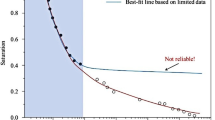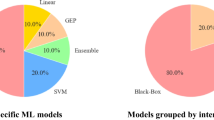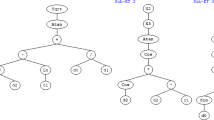Abstract
In the present study, a prediction model was derived for the effective angle of shearing resistance (ϕ′) of soils using a novel hybrid method coupling genetic programming (GP) and orthogonal least squares algorithm (OLS). The proposed nonlinear model relates ϕ′ to the basic soil physical properties. A comprehensive experimental database of consolidated-drained triaxial tests was used to develop the model. Traditional GP and least square regression analyses were performed to benchmark the GP/OLS model against classical approaches. Validity of the model was verified using a part of laboratory data that were not involved in the calibration process. The statistical measures of correlation coefficient, root mean squared error, and mean absolute percent error were used to evaluate the performance of the models. Sensitivity and parametric analyses were conducted and discussed. The GP/OLS-based formula precisely estimates the ϕ′ values for a number of soil samples. The proposed model provides a better prediction performance than the traditional GP and regression models.














Similar content being viewed by others
References
Mollahasani A, Alavi AH, Gandomi AH, Rashed A (2011) Nonlinear neural-based modeling of soil cohesion intercept. KSCE J Civil Eng 15(5):831–840
Arora KR (1988) Introductory soil engineering. text book, 322, pub.: Nem Chand Jane (Prop.), Standard Publishers Distributors, 1705-NaiSarak, Delhi
Murthy S (2008) Geotechnical engineering: principles and practices of soil mechanics, 2008, 2nd edn. CRC Press/Taylor & Francis, UK
ASTM WK3821 New test method for consolidated drained triaxial compression test for soils
ASTM D 6528 Consolidated undrained direct simple shear testing of cohesive soils
El-Maksoud MAF (2006) Laboratory determining of soil strength parameters in calcareous soils and their effect on chiseling draft prediction. In: Proceedings of energy efficiency and agricultural engineering international conference, vol 9, Rousse, Bulgaria
Bowles JE (1992) Engineering properties of soils and their measurement, 4th edn. McGraw-Hill, New York
Korayem AY, Ismail KM, Sehari SQ (1996) Prediction of soil shear strength and penetration resistance using some soil properties. Missouri J Agric Res 13(4):119–140
Panwar JS, Seimens JC (1972) Shear strength and energy of soil failure related to density and moisture. T ASAE 15:423–427
Terzaghi K, Peck RB, Mesri G (1996) Soil mechanics in engineering practice, 2nd edn. Wiley, New York
Shahin MA, Maier HR, Jaksa MB (2001) Artificial neural network applications in geotechnical engineering. Aust Geomech 36(1):49–62
Alavi AH, Gandomi AH, Mollahasani A, Heshmati AAR (2010) Modeling of maximum dry density and optimum moisture content of stabilized soil using artificial neural networks. J Plant Nutr Soil Sci 173(3):368–379
Heshmati AAR, Alavi AH, Keramati M, Gandomi AH (2009) A radial basis function neural network approach for compressive strength prediction of stabilized soil. Geotech Spec Pub ASCE 191:147–153
Alavi AH, Ameri M, Gandomi AH, Mirzahosseini MR (2011) Formulation of flow number of asphalt mixes using a hybrid computational method. Constr Build Mater 25(3):1338–1355
Koza J (1992) Genetic programming, on the programming of computers by means of natural selection. MIT Press, Cambridge
Banzhaf W, Nordin P, Keller R, Francone F (1998) Genetic programming—an introduction: on the automatic evolution of computer programs and its application. dpunkt/Morgan Kaufmann, Heidelberg/San Francisco
Johari A, Habibagahi G, Ghahramani (2006) A prediction of soil–water characteristic curve using genetic programming. J Geotech Geoenviron ASCE 132(5):661–665
Gandomi AH, Alavi AH, Sahab MG, Arjmandi P (2010) Formulation of elastic modulus of concrete using linear genetic programming. J Mech Sci Tech 24(6):1011–1017
Gandomi AH, Alavi AH, Sahab MG (2009) New formulation for compressive strength of CFRP confined concrete cylinders using linear genetic programming. Mater Struct 43(7):963–983
Alavi AH, Gandomi AH, Sahab MG, Gandomi M (2010) Multi expression programming: a new approach to formulation of soil classification. Eng Comput 26(2):111–118
Kayadelen C, Günaydın O, Fener M, Demir A, Özvan A (2009) A modeling of the angle of shearing resistance of soils using soft computing systems. Expert Syst Appl 36:11814–11826
Billings S, Korenberg M, Chen S (1988) Identification of nonlinear output-affine systems using an orthogonal least-squares algorithm. Int J Syst Sci 19(8):1559–1568
Chen S, Billings S, Luo W (1989) Orthogonal least squares methods and their application to non-linear system identification. Int J Control 50(5):1873–1896
Gandomi AH, Alavi AH, Mousavi M, Tabatabaei SM (2011) A hybrid computational approach to derive new ground-motion attenuation models. Eng Appl Artif Int 24(4):717–732
Gandomi AH, Alavi AH, Arjmandi P, Aghaeifar A, Seyednoor M (2010) Genetic programming and orthogonal least squares: a hybrid approach to modeling the compressive strength of CFRP-confined concrete cylinders. J Mech Mater Struct 5(5):735–753
Madar J, Abonyi J, Szeifert F (2005) Genetic programming for the identification of nonlinear input-output models. Ind Eng Chem Res 44(9):3178–3186
Pearson R (2003) Selecting nonlinear model structures for computer control. J Process Control 13(1):1–26
Reeves CR (1997) Genetic algorithm for the operations research. INFORMS J Comput 9:231–250
Madár J, Abonyi J, Szeifert F (2004) Genetic programming for system identification. In: Proceedings of Intelligent Systems Design and Applications (ISDA 2004) Conference, Budapest
Cao H, Yu J, Kang L, Chen Y (1999) The kinetic evolutionary modelling of complex systems of chemical reactions. Comput Chem Eng 23(1):143–151
Barends FBJ, Lindenberg JL, DeQuelerij L, Verruijt A, Luger HJ (1999) Geotechnical engineering for transportation infrastructure: theory and practice, planning and design, construction and maintenance. AA Balkema Publishers, Rotterdam
ASTM D 1587 Standard practice for thin-walled tube sampling of soils for geotechnical purposes
Kayadelen C (2008) Estimation of effective stress parameter of unsaturated soils by using artificial neural networks. Int J Numer Anal Meth Geomech 32:1087–1106
Dunlop P, Smith S (2003) Estimating key characteristics of the concrete delivery and placement process using linear regression analysis. Civil Eng Environ Syst 20:273–290
Swingler K (1996) Applying neural networks a practical guide. Academic Press, New York
Rafiq MY, Bugmann G, Easterbrook DJ (2001) Neural network design for engineering applications. Comput Struct 79(17):1541–1552
Madár J, Abonyi J, Szeifert F (2005b) Genetic programming for the identification of nonlinear input-output models, white paper. Retrieved September 05, 2009, from http://www.fmt.vein.hu/softcomp/gp/ie049626e.pdf
Silva S (2007) GPLAB, a genetic programming toolbox for MATLAB, ITQB/UNL[M]. http://gplab.sourceforge.net
Ryan TP (1997) Modern regression methods. Wiley, New York
Maravall A, Gomez V (2004) EViews Software, Ver. 5. Quantitative Micro Software, LLC, Irvine
Smith GN (1986) Probability and statistics in civil engineering. Collins, London
Mollahasani A, Alavi AH, Gandomi AH (2011) Empirical modeling of plate load test moduli of soil via gene expression programming. Comput Geotech 38(2):281–286
Frank IE, Todeschini R (1994) The data analysis handbook. Elsevier, Amsterdam
Golbraikh A, Tropsha A (2002) Beware of q2. J Mol Graph Model 20:269–276
Roy PP, Roy K (2008) On some aspects of variable selection for partial least squares regression models. QSAR Comb Sci 27:302–313
Francone F (2001) Discipulus owner’s manual, Version 4.0. Register Machine Learning Technologies, Littleton
Author information
Authors and Affiliations
Corresponding author
Appendix A
Rights and permissions
About this article
Cite this article
Mousavi, S.M., Alavi, A.H., Mollahasani, A. et al. Formulation of soil angle of shearing resistance using a hybrid GP and OLS method. Engineering with Computers 29, 37–53 (2013). https://doi.org/10.1007/s00366-011-0242-x
Received:
Accepted:
Published:
Issue Date:
DOI: https://doi.org/10.1007/s00366-011-0242-x




